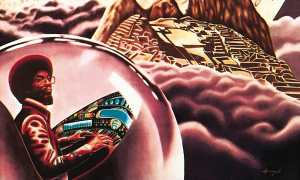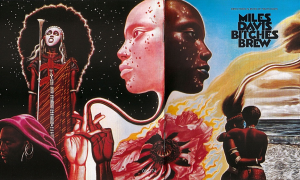Home » Jazz Articles » Rediscovery » Herbie Hancock: Thrust
Herbie Hancock: Thrust

Courtesy Michael Ochs
Fired from the quintet in ‘68, 'for returning late from his honeymoon' (a rather unsympathetic ground for dismissal, although typical of the often icy Davis), Hancock started focusing on his own music, which would increasingly incorporate mainstream elements into his otherwise challenging compositions.
Golden flights.
By the late Sixties Herbie Hancock was already a legend in the Jazz world. At the age of 23 Hancock had joined Miles Davis' new band, which history would dub Davis' Second Great Quintet. Davis was looking to freshen up his sound again, and in 1963 launched said new band featuring young up-and-comers Ron Carter on bass, 17-yr old Tony Williams on drums, and Hancock on keys. This rhythm section went on to reach unheard-of sophistication and originality, helping shape the Post-Bop movement. During his period in the quintet Hancock also released solo albums Empyrean Islands and Maiden Voyage, two of the most popular Jazz albums of that decade.
Fired from the quintet in '68, "for returning late from his honeymoon" (a rather unsympathetic ground for dismissal, although typical of the often icy Davis), Hancock started focusing on his own music, which would increasingly incorporate mainstream elements into his otherwise challenging compositions. Following the peak of his experimental thrust, with the three commercially disappointing 'Mwandishi' albums, Hancock decided to ground his then-stratospheric explorations, rooting them in the earthy foundation of Funk. It was a brilliant move.
The result, in 1973, was Headhunters, a hip-swanging, finger-snapping jazz funk outing, which crossed over into the mainstream Billboard charts. This was followed by Thrust, which, across its four monstrously tight yet galaxy-traversing tracks, seemed to perfectly meld the alchemic reaches of Jazz sophistry with the dizzying musks of Funk.
Like Darth Vader.
The best of funk has a lot in common with the best of cheese (well, for those brave of palate; the others can stick to Fourplay and cheddar)—they contain layers of intrigue, and something almost a little bit off. It's got Whiff.
If Headhunters was embraced by the hip mainstream for its melodic, even rhythmic accessibility, Thrust ventured deeper into the vines and stars.
In the CD-reissue's liner notes, drummer Mike Clark (who created that impossibly groove-infested drumbeat for album opener "Palm Grease" and burns throughout) recalls being invited to join one of Fusion's most exciting and rhythmically daunting groups, and waxes appropriately lyrical. He speaks of "the zone" and meditation, of telepathy with bassist Paul Jackson. He speaks of "'higher levels," and at one point describes Hancock striding into rehearsal with a long black overcoat, looking "like Darth Vader," before swishing down to sit behind the keyboards and letting 'em rip.
The four tracks on Thrust are blistering sonic events. Even the relative ballad, the gorgeous dream "Butterfly," crackles with energy. As beautiful and cool as the melodies weaving from Hancock's hands and flautist Bennie Maupin's mouth are, it is the rhythms (inter-clasped / sidestepping / inventing beats like some kind of flexible, temporal Rubik's cube) that both root the album and let it flourish into space. Thrust contains some of Hancock's most masterful electric explorations, he obviously relishes in the scope of his new instruments, including wah-wah clavinet, and Paul Jackson is somehow beyond en pointe, occasionally playing barely perceptibly just ahead or behind Clark's beats, creating alternatingly a phatter or more forward-leaning groove, amazing. Highest level stuff.
This article was first published in Muse magazine.
< Previous
Camilla George, Bennie Maupin, Sasha ...
Comments
Tags
Jazz in the Aquarian Age
Herbie Hancock
Mick Raubenheimer
Thrust
Headhunters
Mike Clark
BENNIE MAUPIN
Concerts
Sep
13
Fri
For the Love of Jazz
 All About Jazz has been a pillar of jazz since 1995, championing it as an art form and, more importantly, supporting the musicians who create it. Our enduring commitment has made "AAJ" one of the most culturally important websites of its kind, read by hundreds of thousands of fans, musicians and industry figures every month.
All About Jazz has been a pillar of jazz since 1995, championing it as an art form and, more importantly, supporting the musicians who create it. Our enduring commitment has made "AAJ" one of the most culturally important websites of its kind, read by hundreds of thousands of fans, musicians and industry figures every month.























